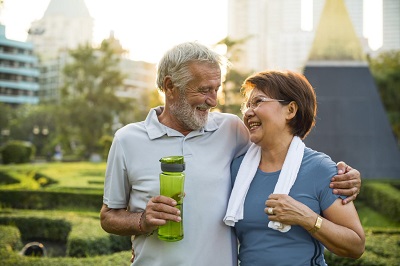Cool Down Your Summer Workout
Despite the heat and humidity, stay active in summer
 You don't have to let summer's blazing sun, heat and humidity stop you from taking your exercise and other activities outside. By taking time to plan, you can enjoy a safe and healthy experience.
You don't have to let summer's blazing sun, heat and humidity stop you from taking your exercise and other activities outside. By taking time to plan, you can enjoy a safe and healthy experience.
Exercising outdoors in the summer sun allows your body to benefit from the sunshine, but your body needs about two weeks to get adjusted to the hot and humid conditions.
During this adjustment, your body begins to produce more dilute sweat more quickly than in cooler weather. This adjustment helps get rid of excess heat gained through exercise so that your core temperature and heart rate stay lower. This reduces the risk of dehydration and other heat-related problems.
Go slow until your body gets used to the heat. Start exercising in the heat for just a few minutes at a time and gradually increase the amount of time as your tolerance builds.
Summer exercise tips:
Avoid high-intensity exercises until you've fully adjusted to the heat.
Avoid peak heat, humidity, and pollution that are usually most intense during the midday. Work out either first thing in the morning or in the late evening.
Go with the shade. Exercising in shady areas, such as tree-lined trails and parks, will help you stay cooler when the temperature rises.
Drink plenty of water in small amounts at a time to stay properly hydrated. The more you sweat, the more you'll need to drink to avoid heat cramps, exhaustion, or worse, heat stroke.
Protect your skin with sunscreen and/or a light-colored, loose-fitting, long-sleeved shirt and a cap.
Wear loose-fitting polyester/cotton blend clothing or other fabrics designed to wick away moisture to help keep your body cooler.
Wear proper fitting shoes with good socks (moisture wicking, not cotton).
Heat exhaustion and heat stroke are the biggest concerns when exercising in the summer heat and humidity.
The first symptoms are usually stomach, arm and/or leg cramps. If you experience cramps, stop exercising, sit down in the shade and rest. Seek help if the cramps don't go away, or if you feel dizzy, nauseated, or start to feel cold and clammy.
Read More
You Don't Have to Call It Exercise
Choose the Best Exercise Intensity for You
Safety Tips for Exercising Outdoors for Older Adults (National Institute on Aging)
Updated on June 17, 2019

